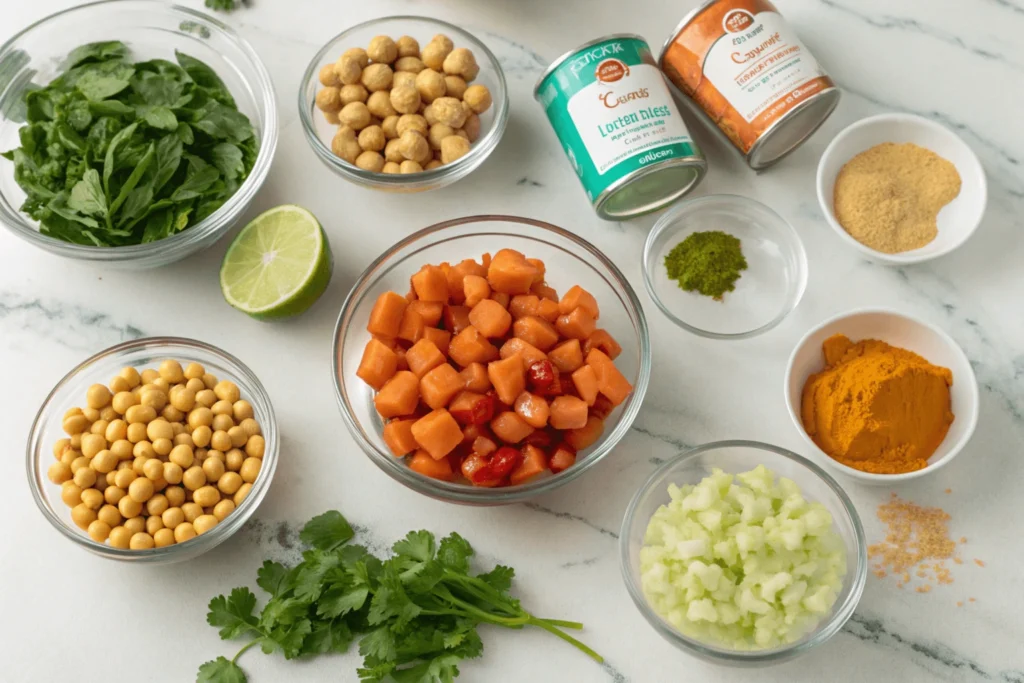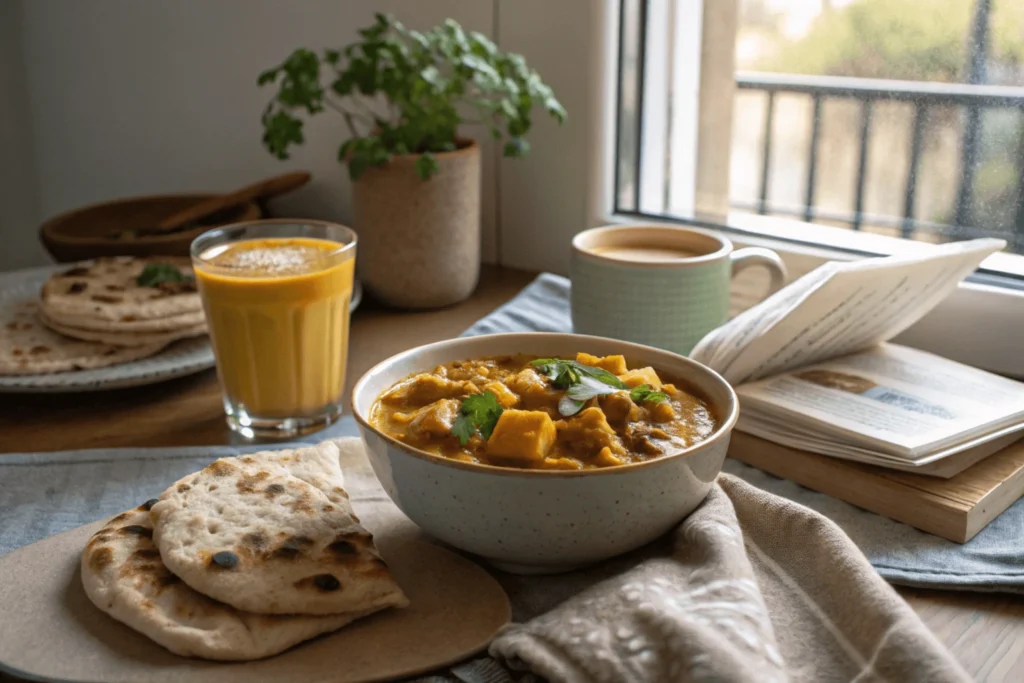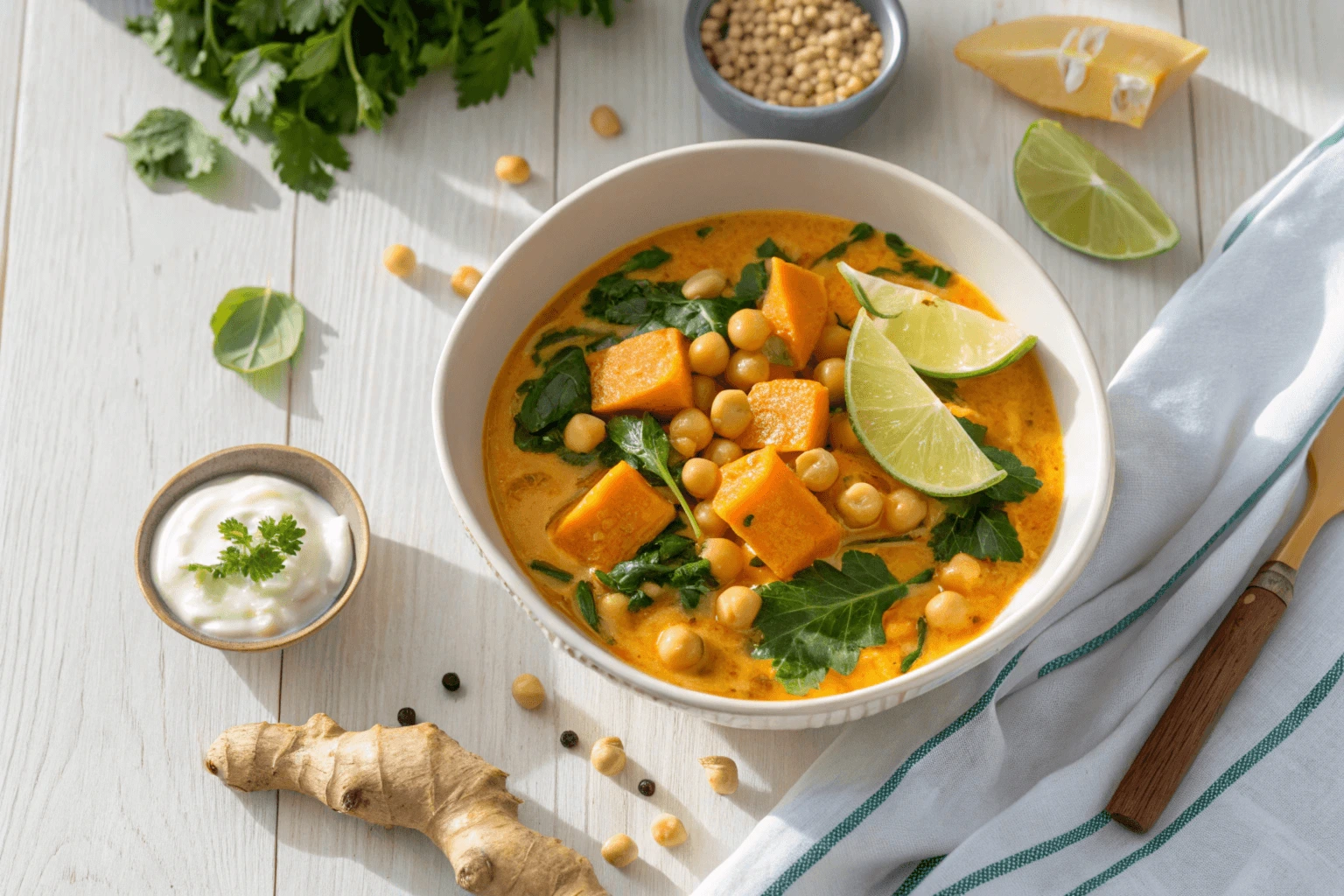Table of Contents

The Best Healthy Breakfast Curry Recipe
- Total Time: 30 minutes
- Yield: 3 servings 1x
Ingredients
- 1 tbsp olive oil or coconut oil
- ½ onion (finely chopped)
- 1 garlic clove (minced)
- 1 tsp ginger (grated)
- 1 small tomato (diced)
- ½ cup bell peppers (chopped)
- ½ cup spinach or kale
- ½ cup cooked chickpeas (or tofu for protein)
- ½ cup light coconut milk
- 1 tsp turmeric
- ½ tsp cumin
- ½ tsp paprika
- ½ tsp garam masala
- Salt & pepper to taste
- Fresh cilantro & lemon wedges (for garnish)
Instructions
- 1️⃣ Sauté: Heat oil in a pan over medium heat. Add onion, garlic, and ginger. Sauté for 2 minutes.
- 2️⃣ Add Spices: Stir in turmeric, cumin, paprika, and garam masala. Cook for 30 seconds.
- 3️⃣ Simmer: Add tomatoes, chickpeas (or tofu), and coconut milk. Let it simmer for 10 minutes.
- 4️⃣ Add Veggies: Stir in bell peppers and spinach. Cook for another 5 minutes.
- 5️⃣ Serve & Enjoy: Garnish with cilantro and a squeeze of lemon. Pair with whole-grain toast or quinoa for a filling
Notes
📝 Pro Tips
✔ For extra protein: Add poached eggs or lentils.
✔ Make it spicy: Add chili flakes or cayenne pepper.
✔ Meal prep: Make a big batch and store in the fridge for 2-3 days.
- Prep Time: 10 minutes
- Cook Time: 20 minutes
- Category: Breakfast, brunch
- Cuisine: Fusion, Healthy, Indian-Inspired
Nutrition
- Calories: 250
Are you tired of the same old breakfast options and looking for something new to spice up your mornings? A healthy breakfast curry might be just what you need! Packed with wholesome ingredients, bold spices, and vibrant flavors, this dish is not only delicious but also a powerhouse of nutrition.
Breakfast curries are a fantastic way to start your day. They’re versatile, easy to make, and perfect for meal prep. Whether you’re following a plant-based diet, looking for high-protein options, or simply craving a warm and satisfying meal, this recipe checks all the boxes.
In this post, we’ll show you how to create the best healthy breakfast curry you’ve ever tried. From nutrient-rich vegetables like sweet potatoes and spinach to flavorful spices like turmeric and curry powder, every ingredient is carefully chosen to fuel your body and delight your taste buds.
Let’s dive in and discover how to make this nourishing breakfast curry a staple in your morning routine! 🌟
Why Choose a Breakfast Curry?
Starting your day with a breakfast curry might seem unconventional to some, but this warming, aromatic dish offers remarkable benefits that make it an excellent choice for your morning meal. The practice of eating curry for breakfast has deep roots in many South and Southeast Asian cultures, where people have long understood its energizing and nourishing properties.
Nutritional Benefits of Breakfast Curries
When you begin your day with a properly prepared breakfast curry, you’re giving your body an incredible array of nutrients. The combination of proteins, whether from legumes, eggs, or lean meats, provides sustained energy throughout your morning. Unlike traditional Western breakfasts that might lead to mid-morning energy crashes, the protein-rich nature of curry helps maintain stable blood sugar levels. The abundance of fiber from vegetables and legumes supports digestive health and helps you feel satisfied until lunch.
What makes breakfast curries particularly special is their impressive micronutrient profile. Turmeric, a standard ingredient in many curries, contains curcumin, which has powerful anti-inflammatory properties. The spinach and other green vegetables often included in breakfast curries deliver essential iron, calcium, and vitamins A and C. These nutrients are particularly well-absorbed because many curry recipes include a small amount of healthy fat, which helps your body utilize fat-soluble vitamins more effectively.
A Perfect Start to Your Day
The aromatic spices in breakfast curry do more than just delight your senses – they actively contribute to your morning energy levels. Turmeric, when combined with black pepper (as it traditionally is in many curry recipes), becomes significantly more bioavailable, helping reduce inflammation and support overall well-being. Ginger, another common curry spice, aids digestion and can help alleviate any morning sluggishness. These warming spices increase circulation and metabolism, naturally energizing you for the day ahead.
The complex flavors of curry also engage your senses fully, helping you practice mindful eating from the start of your day. This mindfulness can set a positive tone for your entire day, improving your relationship with food and supporting better eating habits overall.
Versatile for Any Diet
Perhaps one of the most compelling reasons to choose breakfast curry is its remarkable adaptability to various dietary needs and preferences. For vegetarians and vegans, curry offers countless possibilities using chickpeas, lentils, or tofu as protein sources. Those following gluten-free diets can enjoy curry without modification, as most traditional curry recipes are naturally gluten-free. The basic curry template can be modified to accommodate low-carb diets by adjusting the accompanying sides, or keto diets by incorporating more healthy fats and reducing carbohydrate-heavy ingredients.
I’ll create a clear, structured table showing the ingredients needed for a healthy breakfast curry, with suggested portions and nutritional highlights.
Healthy Breakfast Curry Ingredients Guide

Base Vegetables
| Ingredient | Suggested Amount (per serving) | Nutritional Highlights | Preparation Notes |
|---|---|---|---|
| Sweet Potatoes | 1 medium (200g) | Rich in vitamin A, fiber, complex carbs | Cut into 1-inch cubes |
| Spinach | 2 cups fresh (60g) | Iron, folate, vitamin K | Roughly chopped |
| Tomatoes | 2 medium (200g) | Vitamin C, lycopene, antioxidants | Diced |
| Onions | 1/2 medium (75g) | Prebiotic fiber, antioxidants | Finely chopped |
Protein Sources
| Ingredient | Suggested Amount (per serving) | Nutritional Highlights | Preparation Notes |
|---|---|---|---|
| Chickpeas | 1 cup cooked (240g) | Protein, fiber, iron | Drain and rinse if canned |
| Red Lentils | 1/2 cup dry (100g) | Protein, iron, folate | Rinse before cooking |
| Tofu (firm) | 200g | Complete protein, calcium | Cut into 1-inch cubes |
Essential Spices
| Spice | Suggested Amount | Health Benefits | Storage Tips |
|---|---|---|---|
| Curry Powder | 1-2 tablespoons | Anti-inflammatory properties | Store in airtight container |
| Ground Turmeric | 1 teaspoon | Curcumin, anti-inflammatory | Keep away from light |
| Fresh Ginger | 1 tablespoon, minced | Digestive aid, anti-nausea | Store in freezer |
| Fresh Garlic | 2-3 cloves, minced | Immune support, heart health | Store in cool, dry place |
Optional Additions
| Ingredient | Suggested Amount | Purpose | Notes |
|---|---|---|---|
| Coconut Milk | 1/2 cup (120ml) | Adds creaminess, healthy fats | Light or full-fat options |
| Fresh Cilantro | 1/4 cup chopped | Garnish, fresh flavor | Add just before serving |
| Lime Wedges | 1 lime | Brightness, vitamin C | Serve on the side |
| Greek Yogurt | 2 tablespoons | Protein, cooling element | Optional dairy addition |
Pantry Staples
| Ingredient | Suggested Amount | Purpose | Notes |
|---|---|---|---|
| Olive Oil | 2 tablespoons | Cooking base, healthy fats | Use extra virgin |
| Salt | To taste | Flavor enhancement | Sea salt or kosher |
| Black Pepper | 1/4 teaspoon | Enhances turmeric absorption | Freshly ground |
| Vegetable Stock | 1 cup (240ml) | Base liquid | Low-sodium preferred |
I’ve organized the ingredients into logical categories and included helpful information about portions, nutritional benefits, and preparation notes. The table provides flexibility to adjust portions based on your needs while maintaining the essential elements of a healthy breakfast curry.
Some key features of this guide:
- Portions are suggested for a single generous serving
- Multiple protein options are provided to accommodate different dietary preferences
- Spice amounts can be adjusted according to taste
- Optional additions allow for customization while maintaining the core healthy elements

Step-by-Step Guide to Making the Best Breakfast Curry
Crafting the perfect breakfast curry is an art that combines proper preparation with attention to timing and technique. Let me walk you through each stage of the process, explaining not just what to do, but why each step matters for creating a delicious and nutritious morning meal.
Step 1: Prep Your Ingredients
Proper preparation is crucial for a smooth cooking experience and ensures all ingredients are ready when needed. Begin by gathering all your ingredients in one place – professional chefs call this “mise en place,” and it’s especially important for curry-making where timing matters.
Start by washing and peeling your sweet potatoes, then cut them into uniform 1-inch cubes. This size allows them to cook evenly and quickly, essential for a breakfast dish. Finely dice your onions – smaller pieces will break down more readily, creating a smoother curry base. Mince your garlic and ginger together; when minced, they release their essential oils more effectively, developing deeper flavor. If using fresh tomatoes, dice them into medium chunks, as they’ll break down during cooking.
Take a moment to measure out your spices before you begin cooking. This prevents the chaos of trying to measure spices while your onions are browning. Toast your whole spices if using them – this quick step awakens their essential oils and intensifies their flavors.
Step 2: Start with a Flavorful Base
The foundation of any great curry lies in properly developing its base flavors. Heat your pan over medium heat and add a generous splash of olive oil. Once the oil is shimmering but not smoking, add your diced onions. Cook them slowly, stirring occasionally, until they turn translucent and begin to caramelize slightly – this usually takes about 5-7 minutes. The natural sugars in the onions will develop, creating a sweet depth that balances the spicy elements to come.
Now add your minced garlic and ginger. These aromatics are more delicate than onions, which is why we add them later. Stir constantly for about 30 seconds until you smell their fragrance – this is your cue that they’re ready, but not yet bitter from overcooking. Add your curry powder and additional turmeric now, stirring constantly for another minute. This step, known as “blooming” the spices, allows their fat-soluble flavor compounds to fully develop in the oil.
Step 3: Add the Core Ingredients
This is where your curry really begins to take shape. Add your diced sweet potatoes first, stirring to coat them with the spiced oil. Let them cook for about 2-3 minutes, allowing them to pick up some color from the pan. This brief searing helps develop their natural sweetness and creates a more complex flavor profile.
Pour in your coconut milk, stirring to incorporate all the spiced oil into the liquid. Add your chickpeas now if using them – they’re already cooked, so they just need to heat through and absorb the flavors of the curry. If you’re using dried lentils instead, add them now along with enough water or vegetable stock to cover everything by about an inch.
Step 4: Simmer and Serve
Cover your pan and reduce the heat to maintain a gentle simmer. This is where patience pays off – rushing this step can leave you with undercooked sweet potatoes or a thin sauce. Let everything simmer for about 15-20 minutes, stirring occasionally to prevent sticking. You’ll know it’s ready when the sweet potatoes are tender when pierced with a fork, and the sauce has thickened to your liking.
In the final minutes of cooking, stir in your fresh spinach leaves and let them wilt into the curry. They’ll cook quickly, maintaining their bright color and nutrients. Taste and adjust the seasoning with salt and pepper as needed. A squeeze of fresh lime juice at this point can really brighten all the flavors.
Serve your curry hot, garnished generously with fresh cilantro. The cilantro isn’t just decorative – its bright, citrusy notes provide a perfect contrast to the rich, spiced curry. Consider serving with a dollop of Greek yogurt on top, which adds protein and helps cool the spice level while adding a creamy tanginess.
Tips for Customizing Your Breakfast Curry
Creating a breakfast curry that perfectly suits your tastes and lifestyle doesn’t have to be complicated. Let me guide you through various ways to adapt this versatile dish, explaining not just what you can change, but why and how these modifications work together.
Make It Meal Prep-Friendly
Understanding the science of meal prepping can transform your breakfast curry from a weekend luxury into an everyday convenience. The beauty of curry lies in how its flavors actually develop and deepen over time, making it an ideal candidate for advance preparation. As the dish rests in your refrigerator, the spices continue to infuse the ingredients, creating even more complex and satisfying flavors.
When preparing curry for meal prep, consider cooking your vegetables slightly less than you normally would. This prevents them from becoming too soft during reheating. Sweet potatoes, for instance, should be just tender when pierced with a fork, as they’ll continue to soften slightly during storage and reheating. Store your curry in airtight containers, making sure to cool it completely before refrigerating to prevent condensation, which could make your curry watery.
For the freshest experience throughout the week, consider storing your garnishes separately. Fresh herbs like cilantro can be kept in a damp paper towel, while yogurt or lime wedges should always be added just before serving. Your curry will stay fresh in the refrigerator for up to four days, making it perfect for Monday through Thursday breakfasts.
Switch Up the Base
The foundation of your curry can be adapted to match your nutritional needs and preferences, much like choosing the right canvas for a painting. Traditional rice works beautifully, but each alternative brings its own benefits and flavor profile to the dish.
Quinoa adds a nutty flavor while providing complete protein, making it especially valuable for plant-based diets. Its texture also holds up well when reheated, maintaining a pleasant bite that contrasts nicely with the creamy curry sauce. Cauliflower rice, on the other hand, dramatically reduces the carbohydrate content while adding extra vegetables to your meal. When preparing cauliflower rice, sauté it briefly before adding the curry to remove excess moisture and prevent your dish from becoming watery.
Adjust Spice Levels
Understanding how to modify the heat level of your curry opens up possibilities for serving it to different palates while maintaining its essential character. Think of spice as a dial you can adjust rather than an on-off switch. Start with your base curry powder, which provides warmth and depth without necessarily adding heat, then build from there.
For those who enjoy heat, fresh chili flakes offer not just spiciness but also a bright, fresh flavor that works particularly well at breakfast. Add them gradually, tasting as you go – remember that the heat level will intensify slightly as the curry simmers. For a milder curry that children can enjoy, focus on aromatic spices like cinnamon, cardamom, and turmeric, which provide flavor without heat. Consider serving yogurt or coconut milk on the side, as dairy and dairy alternatives can help temper spiciness for those who find the curry too hot.
Protein Variations
Think of protein additions as a way to not just boost nutrition but also create entirely new variations of your breakfast curry. Each protein option brings its own texture and flavor profile while interacting differently with the curry sauce.
Eggs can be incorporated in several ways, each offering a different experience. Soft-boiled eggs, when halved and placed on top of the curry, create a luxurious sauce when the yolk mixes with the curry. Alternatively, crack eggs directly into small wells in your simmering curry for a shakshuka-like dish. The eggs will gently poach in the flavorful sauce.
Paneer, a fresh Indian cheese, adds a delightful texture and mild flavor that complements rather than competes with your curry sauce. Its ability to hold its shape while warming in the curry makes it perfect for meal prep versions. If using paneer, consider lightly frying it first to create a golden crust that will hold up better in the sauce.
For those seeking a leaner protein option, chicken breast can be diced and gently poached in the curry sauce. The key is to add it at the right moment – too early and it becomes tough, too late and it won’t absorb enough flavor. Add diced chicken when your vegetables are about halfway done, allowing it to cook through gently while remaining tender.
Print
The Best Healthy Breakfast Curry Recipe
- Total Time: 30 minutes
- Yield: 3 servings 1x
Ingredients
- 1 tbsp olive oil or coconut oil
- ½ onion (finely chopped)
- 1 garlic clove (minced)
- 1 tsp ginger (grated)
- 1 small tomato (diced)
- ½ cup bell peppers (chopped)
- ½ cup spinach or kale
- ½ cup cooked chickpeas (or tofu for protein)
- ½ cup light coconut milk
- 1 tsp turmeric
- ½ tsp cumin
- ½ tsp paprika
- ½ tsp garam masala
- Salt & pepper to taste
- Fresh cilantro & lemon wedges (for garnish)
Instructions
- 1️⃣ Sauté: Heat oil in a pan over medium heat. Add onion, garlic, and ginger. Sauté for 2 minutes.
- 2️⃣ Add Spices: Stir in turmeric, cumin, paprika, and garam masala. Cook for 30 seconds.
- 3️⃣ Simmer: Add tomatoes, chickpeas (or tofu), and coconut milk. Let it simmer for 10 minutes.
- 4️⃣ Add Veggies: Stir in bell peppers and spinach. Cook for another 5 minutes.
- 5️⃣ Serve & Enjoy: Garnish with cilantro and a squeeze of lemon. Pair with whole-grain toast or quinoa for a filling
Notes
📝 Pro Tips
✔ For extra protein: Add poached eggs or lentils.
✔ Make it spicy: Add chili flakes or cayenne pepper.
✔ Meal prep: Make a big batch and store in the fridge for 2-3 days.
- Prep Time: 10 minutes
- Cook Time: 20 minutes
- Category: Breakfast, brunch
- Cuisine: Fusion, Healthy, Indian-Inspired
Nutrition
- Calories: 250
Frequently Asked Questions About Breakfast Curry
Let me address some common questions about breakfast curry, providing comprehensive answers that will help you understand not just the what, but the why behind each aspect of this nutritious morning meal.
Is curry a good choice for breakfast?
Breakfast curry represents an excellent morning choice, and understanding the science behind this helps explain why. When we eat curry for breakfast, we’re actually providing our bodies with an ideal combination of nutrients that support sustained energy and mental clarity throughout the morning.
The complex carbohydrates from ingredients like sweet potatoes release glucose slowly into your bloodstream, preventing the energy crashes often associated with traditional sugar-heavy breakfasts. Meanwhile, the healthy fats from coconut milk or olive oil help slow digestion even further while supporting the absorption of fat-soluble vitamins and minerals from the vegetables.
Perhaps most importantly, the spices in curry play a crucial role in morning wellness. Turmeric contains curcumin, which has been shown to reduce inflammation and support brain function. Ginger aids digestion and can help alleviate any morning stomach discomfort. These warming spices also naturally increase circulation, helping you feel more alert and energized without relying on caffeine alone.
Can I make this curry vegan?
Understanding how to create a satisfying vegan curry requires knowing which ingredients provide the richness and depth traditionally derived from animal products. The good news is that breakfast curry is naturally well-suited to vegan adaptation, often becoming even more nutritious in the process.
Coconut milk serves as the perfect base, providing the creamy texture some might miss from dairy while adding healthy fats and subtle sweetness. For protein, chickpeas and lentils work beautifully, offering not just protein but also fiber and minerals. These legumes actually absorb curry flavors more effectively than many animal proteins, creating a more harmonious dish.
If you’re concerned about getting enough protein in your vegan curry, consider adding tofu, which takes on the flavors of the curry beautifully while providing all essential amino acids. You can also sprinkle pumpkin seeds or hemp seeds on top for an extra protein boost and pleasant textural contrast.
How long does it take to cook?
The total time investment for breakfast curry breaks down into two parts: active preparation and passive cooking time. Understanding this distinction helps you plan your morning effectively. The actual hands-on prep time is surprisingly brief – about 10-15 minutes for chopping vegetables and measuring spices. The cooking process then takes approximately 20-25 minutes, but most of this is passive time where the curry simmers unattended.
To make this even more time-efficient, consider these strategies:
- Prep vegetables the night before and store them in airtight containers
- Make larger batches during weekend meal prep
- Keep pre-measured spice blends ready to use
- Use a pressure cooker or instant pot to reduce cooking time by half
What can I serve alongside breakfast curry?
Choosing accompaniments for breakfast curry involves understanding how different elements can complement both the nutritional profile and flavor balance of your curry. Think of these sides as supporting actors that enhance the main performance without overshadowing it.
Naan or whole grain toast serves multiple purposes – it provides additional complex carbohydrates and helps you enjoy every last bit of the flavorful curry sauce. If you’re watching carbohydrates, consider making coconut flour flatbreads as an alternative.
A smoothie alongside your curry might seem unconventional, but it works surprisingly well. Choose ingredients that complement rather than compete with your curry – a mango-based smoothie, for instance, pairs beautifully with the spices while adding additional vitamins and fiber. The cool smoothie also provides a pleasant temperature contrast to the warm curry.
For added protein and probiotics, a side of Greek yogurt works wonderfully. It can be dolloped on top of the curry or served separately, and its tanginess helps balance the rich, spiced flavors of the curry while providing a cooling effect if you’ve made your curry particularly spicy.
Conclusion
A healthy breakfast curry is a game-changer for anyone looking to start their day with a flavorful, nutritious meal. Bursting with wholesome ingredients like sweet potatoes, chickpeas, and vibrant spices, this dish offers a perfect balance of taste and health. Whether you’re meal-prepping for a busy week or enjoying a leisurely morning, this versatile recipe can be tailored to suit your preferences and dietary needs.
Now that you’ve discovered how easy it is to whip up this delicious breakfast curry, it’s time to bring it into your kitchen. Experiment with different ingredients, adjust the spice levels, and make it your own. Share this recipe with family and friends—they’ll thank you for it!
Don’t forget to leave a comment below and let us know how your curry turned out. Here’s to starting your mornings the flavorful way!
Last Updated on May 31, 2025 by Carla


